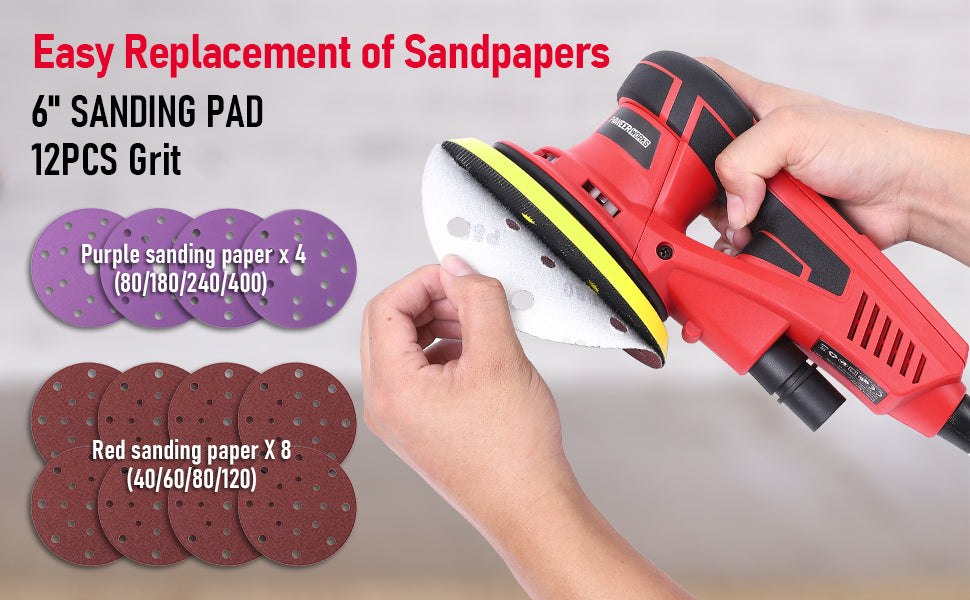Electric Sander for Easy Fine Sanding
If you are doing some renovations at home or if you are a maintenance contractor an orbital sander is a tool that comes in handy to smoothen all those rough wooden surfaces. Even if you are building a princess castle or a treehouse for your kids, a sander is an ideal device to achieve a fine finish and avoid the children from getting hurt from rough cut wood.
Have a look at the GARVEE electric random orbital sander, a device that can finish all your sanding tasks in a giffy.
The GARVEE Electric Random Orbital Sander
This is an orbital sander that can give you the desired finish and fine sanding with ease. It houses an brushless AC motor that uses advanced brushless technology. The sander is fitted with high-quality components that gives it longer life and makes it ideal for long hours of sanding. The capacity to handle long hours of work makes it an excellent device for large scale wood factories.
Superb Performance
GARVEE’s electric random sander have five speed functions ranging from 4,000 to 10,000 RPM. There is also a turbo mode which will help you finish sanding in half the actual time required. These speed functions are perfect for a variety of applications including fine sanding. Being a motor powerful enough to run at 10,000 RPM you might think that this machine is noisy. But it is not!
The orbital sander features whisper quiet operation. It is a precision-balanced motor with low vibration performance for smoother finish. A 3/16-inch orbit provides a swirl-free finish.
User friendly operation
This is an ergonomic machine that can fit comfortably in your palms even if you have short fingers. It is lightweight and weighs only 4.8lbs. It is easily portable and the compact design help it fit into any toolbox easily.
Included sandpapers
There are 12 sandpapers that are included with the package. There are 40- to 60-grit coarse sandpapers for heavy sanding and stripping. For smoothing surfaces and removing small imperfections there are 80- to 120-grit sandpaper. For finishing surfaces smoothly, you can use the included super fine sandpaper with 400-grit. The 240 grit paper should be used for sanding finishes between consecutive coats and drywall and wood.
FAQs
1 - What are orbital sanders?
Orbital sanders are handheld power tools used for sanding and smoothing surfaces such as wood, plastic, and metal. They are widely used in woodworking and construction for tasks such as sanding floors, cabinets, furniture, and walls.
These devices use a round sanding pad that moves in a random or circular motion, which allows for smooth and even sanding without leaving swirl marks or scratches on the surface. The sanding pad is attached to the sander with a hook-and-loop system, making it easy to replace when worn out or damaged.
Orbital sanders come in various sizes, including 1/4 sheet, 1/2 sheet, and random orbit sanders. The size of the sander and the grit of the sandpaper used depends on the size of the surface to be sanded and the level of smoothing required.
Orbital sanders are generally easy to use and are suitable for both novice and experienced users. They offer a faster and more efficient way to sand surfaces than manual sanding, making them an essential tool for any DIY enthusiast, woodworker, or construction worker.
2 - What are types of orbital sanders?
There are three main types of orbital sanders:
-
Random orbital sanders: These sanders move the sanding pad in an elliptical motion, which helps to prevent swirl marks and produce a smooth finish. They are suitable for sanding both flat and curved surfaces and come in different sizes, including 5-inch and 6-inch models. Random orbital sanders are the most versatile type of orbital sander.
-
Sheet orbital sanders: These sanders use a square or rectangular sandpaper sheet, typically 1/4 or 1/2 sheet, which is attached to the sander with a clamping system. They are good for sanding large, flat surfaces such as walls, floors, and tabletops.
-
Finishing sanders: Also known as palm sanders, these are smaller and lighter than other types of orbital sanders. They are designed for fine sanding and finishing work on small or intricate surfaces, such as furniture or trim. Finishing sanders typically use quarter-sheet or half-sheet sandpaper and may have a rectangular or triangular sanding pad.
3 - What to check before using a orbital sander?
Ensure the sandpaper is properly attached to the sanding pad and is the correct type and grit for the job. Also, check that the sandpaper is not worn out, torn or damaged. Check that the dust collection system is properly attached and functioning. Empty the dust bag or connect the vacuum to the sander.
Things to Consider while Buying Orbital Sanders
Here are some factors to consider before buying an orbital sander:
Type of sander: Determine the type of sander you need based on the job at hand. Random orbital sanders are the most versatile and suitable for most tasks, while sheet orbital sanders and finishing sanders are more specialized.
- Power: Consider the power of the sander, which is usually measured in amps or volts. Higher-powered sanders can sand faster and remove more material, but may also be heavier and more difficult to control.
- Size of sanding pad: The size of the sanding pad determines the amount of surface area you can cover at one time. Larger pads are better for larger surfaces, while smaller pads are suitable for intricate work.
- Dust collection: Sanding generates a lot of dust, so look for a sander with a good dust collection system, such as a dust bag or vacuum attachment.
- Speed settings: Some sanders have adjustable speed settings, which can be useful for different materials and sanding tasks.
- Ergonomics: Consider the ergonomics of the sander, including its weight, balance, and grip. A comfortable and easy-to-use sander can reduce fatigue and improve accuracy.











